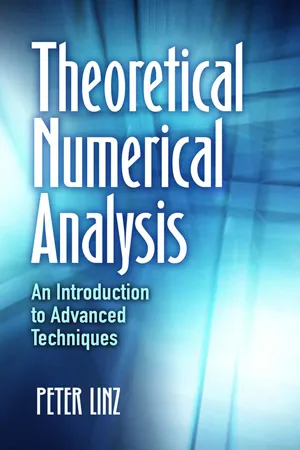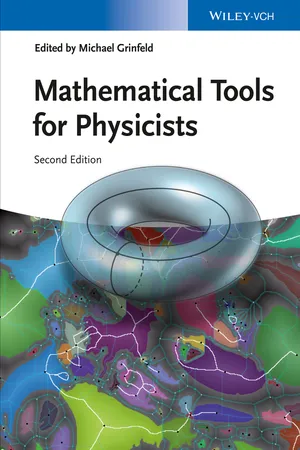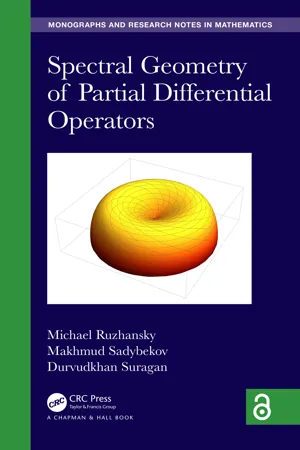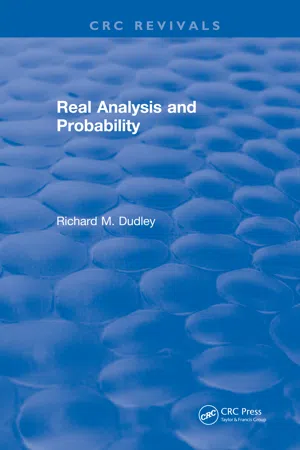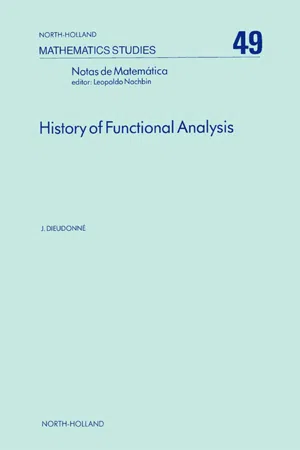Mathematics
Functional Analysis
Functional analysis is a branch of mathematics that studies vector spaces equipped with functions. It deals with the study of spaces of functions and their properties, such as continuity, differentiability, and integrability. It has applications in many areas of mathematics, physics, and engineering.
Written by Perlego with AI-assistance
Related key terms
Related key terms
1 of 4
Related key terms
1 of 3
6 Key excerpts on "Functional Analysis"
- eBook - ePub
Theoretical Numerical Analysis
An Introduction to Advanced Techniques
- Peter Linz(Author)
- 2019(Publication Date)
- Dover Publications(Publisher)
We will begin by reviewing some simple results from Functional Analysis and approximation theory. A knowledge of these concepts is indispensable for further work; Functional Analysis provides us with a language for the development of a general theory, while approximation theory makes it possible to relate this theory to specific cases in a meaningful way. Both subjects are of course very extensive and contain topics of little use to the numerical analyst. Fortunately, the ideas needed here are the simpler ones, so that we need not delve into these subjects very deeply.Passage contains an image
1
REVIEW OF Functional Analysis
Modern numerical analysis has benefited considerably from its close association with Functional Analysis, which provides it not only with an elegant and concise notation, but also with an efficient tool for the development of new theories. Because of this, it is becoming increasingly more difficult for anyone unfamiliar with Functional Analysis to appreciate the current developments in numerical analysis. Fortunately, matters are not as difficult as they sometimes seem and it is not necessary to become an expert in Functional Analysis; what we mainly need here is a working knowledge of some quite simple concepts. This chapter is devoted to a review of the most basic ideas of Functional Analysis which, for the most part, are sufficient for further discussions. Occasionally, particularly in later chapters, a few more sophisticated concepts will be helpful, but these will be introduced when needed.1.1 LINEAR SPACES
DEFINITION 1.1. Let X = {x,y,z...} be a set and F={α,β,γ,...} a scalar field. Let there be defined an operation of addition between every two elements of X, and an operation of scalar multiplication between every element of F and every element of X such that(a) If x is in X and y is in X then x + y is in X. In mathematical shorthand notation we will write this as x ∈ X, y ∈ X ⇒ x + y ∈ X - eBook - ePub
- Michael Grinfeld(Author)
- 2014(Publication Date)
- Wiley-VCH(Publisher)
13 Functional AnalysisPavel ExnerThe area covered by the chapter title is huge. We describe the part of Functional Analysis dealing with linear operators, in particular, those on Hilbert spaces and their spectral decompositions, which are important for applications in quantum physics. The claims are presented without proofs, often highly nontrivial, for which we refer to the literature mentioned at the end of the chapter.13.1 Banach Space and Operators on Them
The first section summarizes notions from the general Functional Analysis that we will need in the following.13.1.1 Vector and Normed Spaces
The starting point is the notion of a vector space V over a field 𝔽 as a family of vectors equipped with the operations of summation and multiplication by a scalar . The former is commutative and associative, and the two operations are mutually distributive. We consider here the case when , the set of complex numbers, but other fields are also used, typically the sets of reals or quaternions.Standard examples are , the space of n-tuples of complex numbers, or ℓp, the space of complex sequences satisfying for a fixed p ≥ 1. Other frequently occurring examples are function spaces such as consisting of continuous functions on the interval ℐ, or the elements of which are classes of functions differing on a zero-measure set and satisfying . The dimension of a vector space is given by the maximum number of linearly independent vectors one can find in it. In the examples, the space is n-dimensional, the other indicated ones are (countably) infinite-dimensional.A map is called a functional. We say that it is linear if and antilinear if for all and x ∈ V. Similarly, a seminorm is a real functional p satisfying and . A map is called a form. Its (anti)linearity is defined as above; it is called sesquilinear if it is linear in one argument and antilinear in the other.A norm on a vector space is a seminorm, usually denoted as , with the property that implies x = 0. A space equipped with it is called a normed space. The same vector space can be equipped with different norms, for example both and are norms on . Analogous norms can be introduced on the other vector spaces mentioned above, for instance, on or on - Michael Ruzhansky, Makhmud Sadybekov, Durvudkhan Suragan(Authors)
- 2020(Publication Date)
- Chapman and Hall/CRC(Publisher)
Chapter 1 Functional spacesThis chapter contains a brief and basic introduction to the part of the Functional Analysis dealing with function spaces. This chapter, as well as the next two, are aimed to serve as a “guidebook” indicating the main directions and necessary facts. As there is a large variety of sources available, and as the material of the first three chapters can be readily found in numerous monographs with much detail, we avoid giving technical proofs but restrict ourselves here to giving an exposition of main ideas, concepts, and their main properties.Thus, as a rule, main theorems are introduced without proofs, which can be found in the extensive mathematical literature. Here, our goal is the explanation of introduced concepts and properties in concrete simple examples.There are numerous excellent books containing very detailed and rigorous exposition of the material of the first two or three chapters on the basics of the Functional Analysis. We can only mention a few, such as the books by Reed and Simon [93 ; 94 ], Davies [32 ], Gohberg and Kreĭn [44 ], Lax [72 ], and many others. For a more informal introduction to basic and more advanced analysis and measure theory we can also recommend [106 ], with the additional emphasis put on the Fourier analysis aspects of the operator theory.However, one distinguishing feature of our presentation is the particular emphasis put on many examples related to the theory of differential equations.The following conventions will apply to the material throughout the whole book. New terms appearing in the text are in italics and in bold. For the convenience of the reader, the logical completion of a separate idea, justification of an approval, discussions of theorems, lemmas and remarks, consideration of an example, proofs, etc., are denoted by the symbol □1.1 Normed spacesWe start with the concept of a linear space (or a vector space) which is the basic notion of the (linear) Functional Analysis. A collection X of elements is called a linear space if any linear combination of them still belongs to X- eBook - ePub
- Jiguang Sun, Aihui Zhou(Authors)
- 2016(Publication Date)
- Chapman and Hall/CRC(Publisher)
Chapter 1Functional Analysis
1.1 Basics 1.1.1 Metric Spaces, Banach Spaces and Hilbert Spaces 1.1.2 Linear Operators 1.1.3 Spectral Theory of Linear Operators 1.2 Sobolev Spaces 1.2.1 Basic Concepts 1.2.2 Negative Norm 1.2.3 Trace Spaces 1.3 Variational Formulation 1.4 Abstract Spectral Approximation Theories 1.4.1 Theory of Descloux, Nassif, and Rappaz 1.4.2 Theory of Babuška and Osborn 1.4.3 Variationally Formulated Eigenvalue Problems1.1 Basics
The analysis of finite element methods relies on results from Functional Analysis. In this section, we collect some fundamental results which will be used in this book. Most proofs are not provided since the materials can be found in classical textbooks such as [178 , 251 , 79 ], which are the major sources of this chapter.1.1.1 Metric Spaces, Banach Spaces and Hilbert Spaces
Definition 1.1.1. A metric space is a set X together with a metric d (·, ·) defined on X × X such that for all x, y, z ∈ X(1) d (·, ·) is real-valued, finite and non-negative, d (x, y ) = 0 if and only if x = y ;(2) d (x, y ) = d (y, x );(3) d (x, y ) ≤ d (x, z ) + d (z, y ).We also call d a distance function on X . Sometimes we write d X to emphasize that it is a distance function related to space X . Property (3) is called the triangle inequality.Given a point x 0 ∈ X and a real number r > 0, we defineopen ball: B (x 0 ; r ) = {x ∈ X | d (x, x 0 ) < r };closed ball:= { x ∊ X | dB¯(x 0; r )( x ,} ;x 0) ≤ rsphere: S (x 0 ; r ) = {x ∈ X | d (x, x 0 ) = r }.Definition 1.1.2. A subset Y of a metric space X is said to be open if it contains an open ball at each of its points. A subset Y of X is said to be closed if its complement in X is open, i.e., Y c = X \ Y is open.We call x 0 an interior point of a set Y if Y contains an open ball B (x 0 ; є) for some є > 0. The interior of Y is the set of all interior points of Y . Now we can define the continuous mapping.Definition 1.1.3. Let (X, dX) and (Y, dY) be metric spaces. A mapping T - eBook - ePub
- R. M. Dudley(Author)
- 2018(Publication Date)
- Chapman and Hall/CRC(Publisher)
p Spaces; Introduction to Functional AnalysisThe key idea of Functional Analysis is to consider functions as “points” in a space of functions. To begin with, consider bounded, measurable functions on a finite measure spaceWe have not finished with measure theory: a very important fact, the “Radon-Nikodym” theorem, about the relationship of two measures, will be proved in §5.5 using some Functional Analysis.(such as the unit interval with Lebesgue measure. For any two such functions, f and g, we have a finite integral ∫fg dµ = ∫ f (x )g{x ) dµ (x ). If we consider functions as vectors, then this integral has the properties of an inner product or dot product (f , g ): it is nonnegative when f = g, symmetric in the sense that (f , g ) ≡ (g, f ), and linear in f for fixed g. Using this inner product, one can develop an analogue of Euclidean geometry in a space of functions, with a distance d (f, g ) = (f − g, f − g )112 , just as in a finite-dimensional vector space. In fact, if µ is counting measure on a finite set with k elements, (f , g ) becomes the usual inner product of vectors in ℝX , S , μ)k .But if µ is Lebesgue measure on [0, 1], for example, then for the metric space of functions with distance d to be complete, we will need to include some unbounded functions f such that ∫f 2 dµ < ∞. Along the same lines, for each p > 0 and µ there is the collection of functions f which are measurable and for which ∫ |f |p dµ <∞. This collection is called ℒp or ℒp (µ ). It is not immediately clear that if f and g are in ℒp , then so is f + g; this will follow from an inequality for ∫ |f +g|p dµin terms of the corresponding integrals for f and g separately, which will be treated in §5.1. In §§5.3 and 5.4, the inner product idea, corresponding to p = 2, is further developed.5.1 Inequalities for Integrals
On ]0,1] with Lebesgue measure, the function f (x )= xpis integrable if and only if p > − 1. Thus the product of two integrable functions, such as x −1/2 times x −1/2 - eBook - ePub
- J. Dieudonne(Author)
- 1983(Publication Date)
- North Holland(Publisher)
Chapter IXApplications of Functional Analysis to Differential and Partial Differential Equations
I will not try to enumerate all the applications which have been made of Functional Analysis in the last 50 years, and which have amply justified the creators of that discipline. But as we have seen in the first 4 chapters how most notions and problems of Functional Analysis had their origin in questions relative to ordinary or partial differential equations, I think it is worthwhile to give a sketchy description of a few of the most conspicuous progress in those questions which have been made by an imaginative use of the new tools provided by Functional Analysis, mostly spectral theory and the theory of distributions.§1 Fixed Point Theorems
In the first applications which we shall mention, however, little more is used of Banach spaces beyond their definition, and the results primarily concern non linear equations. The main idea is similar to the application of the contraction principle (chap. VI , §3 ) to the local existence theorems for differential equations, by writing them in the form z = F(z) for z in some Banach space E of functions; if B is the closure of an open bounded convex set in E and F is a contraction mapping B into itself, then the contraction principle says there exists a unique solution of z = F(z) in B, what one calls a fixed point for F. But after the first years of the XXth century, new possibilities of obtaining “fixed point theorems” appeared with the first results of a new branch of mathematics, Algebraic Topology, created by H. Poincaré in 1895-1900: using the concepts of that theory, L.E.J. Brouwer could show in 1910 that if B is homeomorphic to a closed ball in some finite dimensional vector space E, and F is any continuous map of B into itself (which is not supposed any more to be a contraction), then F has at least one fixed point in B.The problem was to find a similar theorem applicable to infinite dimensional Banach spaces E. The first result in that direction was obtained in 1922 by G.D. Birkhoff and 0. Kellogg, who considered the case in which E = C(I) or E = ℓ2 , and showed that Brouwer′s theorem could be extended, provided one took for B a compact convex set [22 ]; their fundamental device consists in using the compactness of B to “approximate” it by a finite dimensional compact convex set Bn , and to similarly “approximate” F by a continuous mapping Fn of Bn into itself, to which Brouwer′s theorem may be applied. This method was taken up and greatly expanded by J. Schauder, who showed that it could be applied to any Banach space E, and also, for separable Banach spaces, that one could replace compactness of B and continuity of F by weak compactness and weak continuity ([186 ], [187
Index pages curate the most relevant extracts from our library of academic textbooks. They’ve been created using an in-house natural language model (NLM), each adding context and meaning to key research topics.
Explore more topic indexes
Explore more topic indexes
1 of 6
Explore more topic indexes
1 of 4
